ABS MERCEDES-BENZ S CLASS 2019 Owners Manual
[x] Cancel search | Manufacturer: MERCEDES-BENZ, Model Year: 2019, Model line: S CLASS, Model: MERCEDES-BENZ S CLASS 2019Pages: 578, PDF Size: 23.31 MB
Page 25 of 578
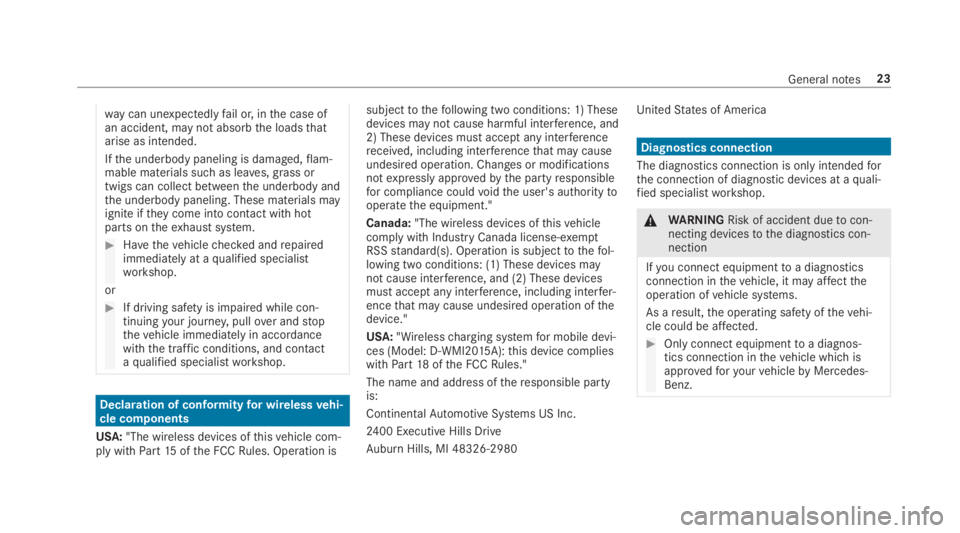
way can unexpectedlyfail or, inthe case ofan accident, may not absorbthe loadsthatarise as intended.
Ifthe underbody paneling is damaged,flam‐mable materials such as leaves, grass ortwigs can collect betweenthe underbody andthe underbody paneling. These materials mayignite iftheycome into contact withhotparts ontheexhaust system.
#Havethevehiclechecked andrepairedimmediately at aqualified specialistworkshop.
or
#If driving safety is impaired while con‐tinuingyour journey,pullover andstopthevehicle immediately in accordancewiththe traffic conditions, and contactaqualified specialistworkshop.
Declaration of conformityfor wirelessvehi‐cle components
USA:"The wireless devices ofthisvehicle com‐ply withPart15ofthe FCCRules. Operation is
subjecttothefollowing two conditions: 1) Thesedevices may not cause harmful interference, and2) These devices mustaccept any interferencereceived, including interferencethat may causeundesired operation. Changes or modificationsnotexpressly approvedbythe partyresponsiblefor compliance couldvoidthe user's authoritytooperatethe equipment."
Canada:"The wireless devices ofthisvehiclecomply with Industry Canada license-exemptRSSstandard(s). Operation is subjecttothefol‐lowing two conditions: (1) These devices maynot cause interference, and (2) These devicesmustaccept any interference, including interfer‐encethat may cause undesired operation ofthedevice."
USA:"Wirelesscharging systemfor mobile devi‐ces (Model: D-WMI2015A):this device complieswithPart18ofthe FCCRules."
The name and address oftheresponsible partyis:
ContinentalAutomotive Systems US Inc.
2400 Executive Hills Drive
Auburn Hills, MI 48326-2980
UnitedStates of America
Diagnostics connection
The diagnostics connection is only intendedforthe connection of diagnostic devices at aquali‐fied specialistworkshop.
&WARNINGRisk of accident duetocon‐necting devicestothe diagnostics con‐nection
Ifyou connect equipmenttoa diagnosticsconnection inthevehicle, it may affecttheoperation ofvehicle systems.
As aresult,the operating safety ofthevehi‐cle could be affected.
#Only connect equipmenttoa diagnos‐tics connection inthevehicle which isapprovedforyourvehiclebyMercedes-Benz.
General notes23
Page 194 of 578
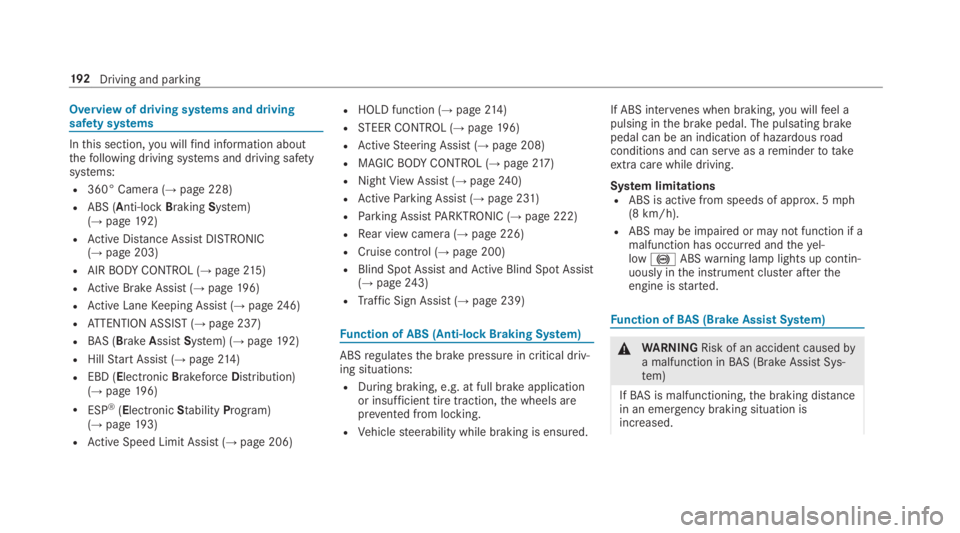
Overview of driving systems and drivingsafety systems
Inthis section,you willfind information aboutthefollowing driving systems and driving safetysystems:
R360° Camera (→page 228)
RABS (Anti-lockBrakingSystem)(→page192)
RActive Distance AssistDISTRONIC(→page203)
RAIRBODYCONTROL (→page215)
RActive Brake Assist (→page196)
RActive LaneKeeping Assist (→page246)
RATTENTION ASSIST (→page 237)
RBAS (BrakeAssistSystem) (→page192)
RHillStart Assist (→page214)
REBD (ElectronicBrakeforceDistribution)(→page196)
RESP®(ElectronicStabilityProgram)(→page193)
RActive Speed Limit Assist (→page 206)
RHOLD function (→page214)
RSTEER CONTROL (→page196)
RActiveSteering Assist (→page 208)
RMAGICBODYCONTROL (→page217)
RNightViewAssist (→page240)
RActiveParking Assist (→page 231)
RParking AssistPARKTRONIC (→page 222)
RRear view camera (→page 226)
RCruise control (→page 200)
RBlind Spot Assist andActive Blind Spot Assist(→page243)
RTraffic Sign Assist (→page 239)
Function of ABS (Anti-lock Braking System)
ABSregulatesthe brake pressure in critical driv‐ing situations:
RDuring braking, e.g. at full brake applicationor insufficient tire traction,the wheels areprevented from locking.
RVehiclesteerability while braking is ensured.
If ABS intervenes when braking,you willfeel apulsing inthe brake pedal. The pulsating brakepedal can be an indication of hazardousroadconditions and can serveas aremindertotakeextra care while driving.
System limitationsRABS is active from speeds of approx. 5mph(8 km/h).
RABS may be impaired or may not function if amalfunction has occurred andtheyel‐low�%ABSwarning lamp lights up contin‐uously inthe instrument cluster aftertheengine isstarted.
Function ofBAS (Brake Assist System)
&WARNINGRisk of an accident causedbya malfunction inBAS (Brake AssistSys‐tem)
IfBAS is malfunctioning,the braking distancein an emergency braking situation isincreased.
19 2Driving and parking
Page 195 of 578
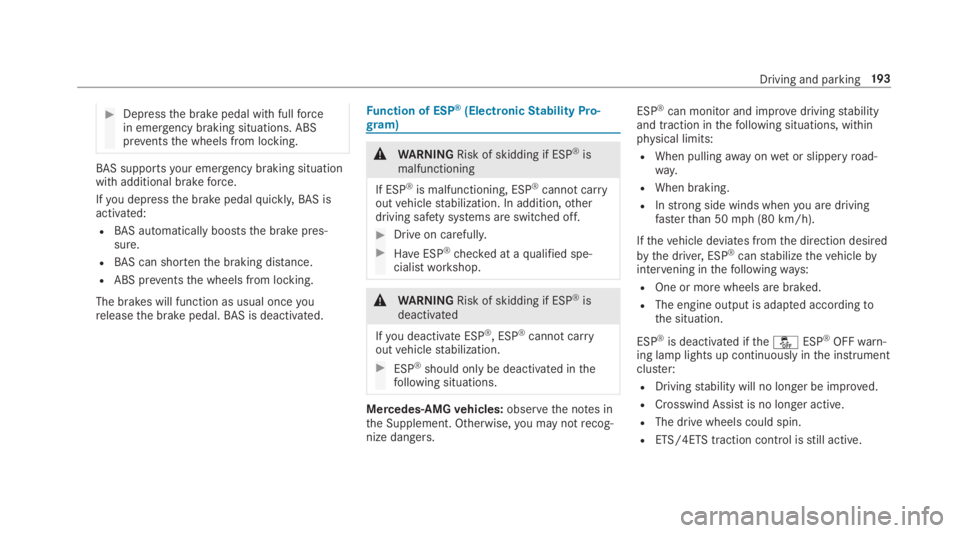
#Depressthe brake pedal with fullforcein emergency braking situations. ABSpreventsthe wheels from locking.
BAS supportsyour emergency braking situationwith additional brakeforce.
Ifyou depressthe brake pedalquickly,BAS isactivated:
RBAS automaticallybooststhe brake pres‐sure.
RBAS can shortenthe braking distance.
RABS preventsthe wheels from locking.
The brakes will function as usual onceyoureleasethe brake pedal.BAS is deactivated.
Function of ESP®(ElectronicStability Pro‐gram)
&WARNINGRisk of skidding if ESP®ismalfunctioning
If ESP®is malfunctioning, ESP®cannot carryoutvehiclestabilization. In addition,otherdriving safety systems are switched off.
#Drive on carefully.
#HaveESP®checked at aqualified spe‐cialistworkshop.
&WARNINGRisk of skidding if ESP®isdeactivated
Ifyou deactivate ESP®, ESP®cannot carryoutvehiclestabilization.
#ESP®should onlybe deactivated inthefollowing situations.
Mercedes‑AMGvehicles:observethe notes inthe Supplement. Otherwise,you may notrecog‐nize dangers.
ESP®can monitor and improvedrivingstabilityand traction inthefollowing situations, withinphysical limits:
RWhen pullingawayonwet or slipperyroad‐way.
RWhen braking.
RInstrong side winds whenyou are drivingfasterthan 50mph (80 km/h).
Ifthevehicle deviates fromthe direction desired
bythe driver, ESP®canstabilizethevehiclebyintervening inthefollowingways:
ROne or more wheels are braked.
RThe engine output is adapted accordingtothe situation.
ESP®is deactivated ifthe�
Page 211 of 578
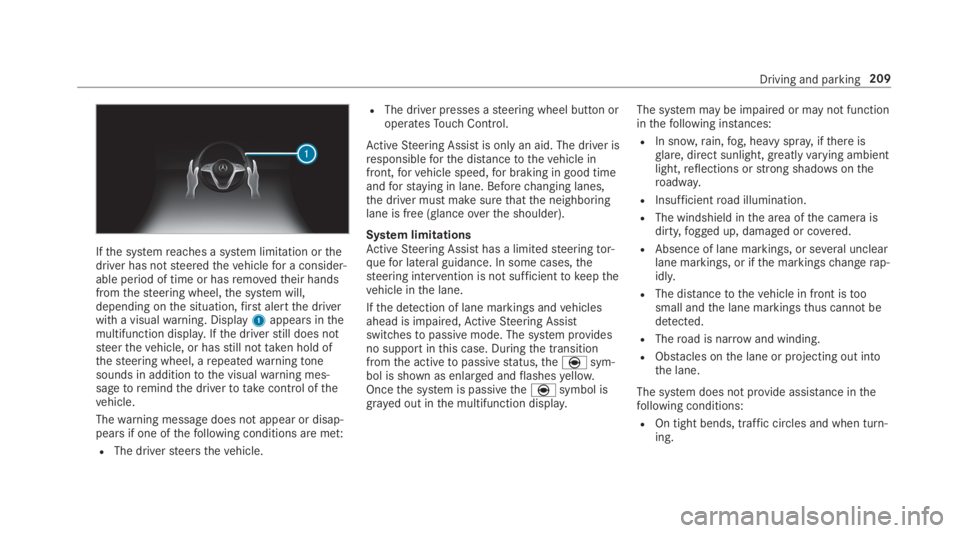
Ifthe systemreaches a system limitation orthedriver has notsteeredthevehiclefor a consider‐able period of time or hasremovedtheir handsfromthesteering wheel,the system will,depending onthe situation,first alertthe driverwith a visualwarning. Display1appears inthemultifunction display.Ifthe driverstill does notsteerthevehicle, or hasstill nottaken hold ofthesteering wheel, arepeatedwarningtonesounds in additiontothe visualwarning mes‐sagetoremindthe drivertotakecontrol ofthevehicle.
Thewarning message does not appear or disap‐pears if one ofthefollowing conditions are met:
RThe driversteersthevehicle.
RThe driver presses asteering wheel button oroperatesTouch Control.
ActiveSteering Assist is only an aid. The driver isresponsibleforthe distancetothevehicle infront,forvehicle speed,for braking in good timeandforstaying in lane. Beforechanging lanes,the driver must make surethatthe neighboringlane is free (glanceoverthe shoulder).
System limitationsActiveSteering Assist has a limitedsteeringtor‐quefor lateral guidance. In some cases,thesteering intervention is not sufficienttokeepthevehicle inthe lane.
Ifthe detection of lane markings andvehiclesahead is impaired,ActiveSteering Assistswitchestopassive mode. The system providesno support inthis case. Duringthe transitionfromthe activetopassivestatus,theèsym‐bol is shown as enlarged andflashesyellow.Oncethe system is passivetheèsymbol isgrayed out inthe multifunction display.
The system may be impaired or may not functioninthefollowing instances:
RIn snow,rain,fog, heavy spray, ifthere isglare, direct sunlight,greatlyvarying ambientlight,reflections orstrong shadowsontheroadway.
RInsufficientroad illumination.
RThe windshield inthe area ofthe camera isdirty,fogged up, damaged or covered.
RAbsence of lane markings, or several unclearlane markings, or ifthe markingschangerap‐idly.
RThe distancetothevehicle in front istoosmall andthe lane markingsthus cannot bedetected.
RTheroad is narrow and winding.
RObstacles onthe lane or projecting out intothe lane.
The system does not provide assistance inthefollowing conditions:
ROn tight bends, traffic circles and when turn‐ing.
Driving and parking209
Page 409 of 578
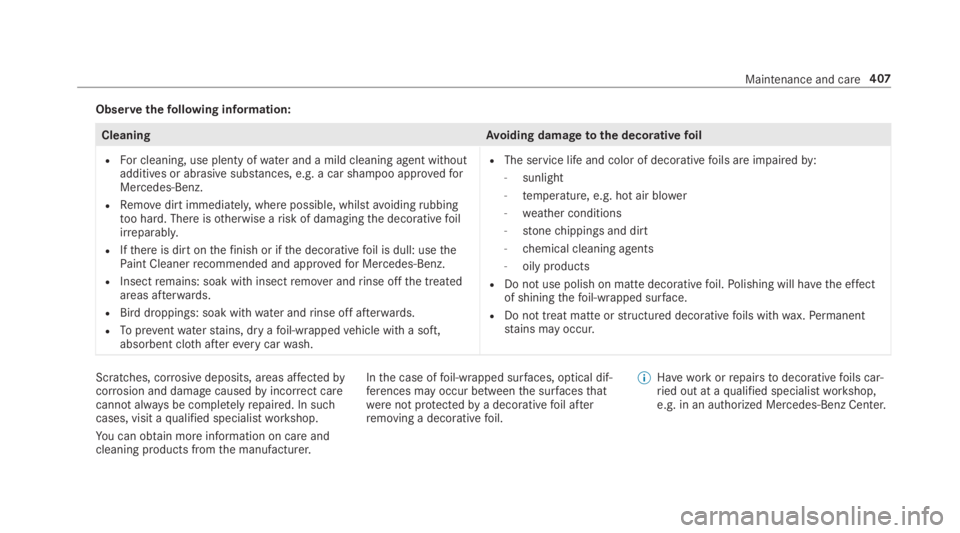
Observethefollowing information:
CleaningAvoiding damagetothe decorativefoil
RFor cleaning, use plenty ofwater and a mild cleaning agent withoutadditives or abrasivesubstances, e.g. a car shampoo approvedforMercedes-Benz.
RRemovedirt immediately, where possible, whilstavoidingrubbingtoo hard. There isotherwise arisk of damagingthe decorativefoilirreparably.
RIfthere is dirt onthefinish or ifthe decorativefoil is dull: usethePaint Cleanerrecommended and approvedfor Mercedes-Benz.
RInsectremains: soak with insectremover andrinse offthe treatedareas afterwards.
RBird droppings: soak withwater andrinse off afterwards.
RTopreventwaterstains, dry afoil-wrappedvehicle with a soft,absorbent clothaftereverycarwash.
RThe service life and color of decorativefoils are impairedby:
-sunlight
-temperature, e.g. hot air blower
-weather conditions
-stonechippings and dirt
-chemical cleaning agents
-oily products
RDo not use polish on matte decorativefoil.Polishing will havethe effectof shiningthefoil-wrapped surface.
RDo not treat matte orstructured decorativefoils withwax.Permanentstains may occur.
Scratches, corrosive deposits, areas affectedbycorrosion and damage causedbyincorrect carecannot alwaysbe completelyrepaired. In suchcases, visit aqualified specialistworkshop.
You can obtain more information on care andcleaning products fromthe manufacturer.
Inthe case offoil-wrapped surfaces, optical dif‐ferences may occur betweenthe surfacesthatwerenot protectedbya decorativefoil afterremoving a decorativefoil.
%Haveworkorrepairstodecorativefoils car‐ried out at aqualified specialistworkshop,e.g. in an authorized Mercedes-Benz Center.
Maintenance and care407
Page 421 of 578

#Toreduce the tire pressure:press pressurerelease button1nexttopressuregauge2.
#Whenthe tire pressure is correct, unscrewthefilling hose fromthevalve ofthe sealedtire.
#Screwthevalve cap ontothevalve ofthesealed tire.
#Pullthe tire sealant bottle out ofthe tireinflation compressor.Thefilling hosestays onthe tire sealant bot‐tle.
#Drivetothe nearestqualified specialistwork‐shop and havethe tire, tire sealant bottle andfilling hosereplacedthere.
Battery(vehicle)
Notes onthe12V battery
&WARNINGRisk of an accident duetoworkcarried out incorrectly onthe bat‐tery
Workcarried out incorrectly onthe batterycan,forexample, leadtoa short circuit. Thiscan leadtofunctionrestrictions in safety-rel‐evant systems,forexamplethe lighting sys‐
tem, ABS (anti-lockbraking system) or ESP®
(ElectronicStability Program). The operatingsafety ofyourvehicle may berestricted.
You could lose control ofthevehicle inthefollowing situations:
Rwhen braking
Rintheevent of abruptsteering maneuversand/or whenthevehicle's speed is notadaptedtotheroad conditions
#Intheevent of a shortcircuit or a simi‐lar incident, contact aqualified special‐istworkshop immediately.
#Do not continue driving.
#Always haveworkonthe battery carriedout at aqualified specialistworkshop.
RFurther information on ABS (→page192)
RFurther information on ESP®(→page193)
For safetyreasons, Mercedes-Benzrecommendsthatyou onlyuse batteries which havebeentes‐ted and approvedforyourvehiclebyMercedes-Benz. These batteries provide increased impactprotectiontopreventvehicle occupants fromsuffering acid burns shouldthe battery be dam‐aged intheevent of an accident.
Breakdown assistance419
Page 426 of 578
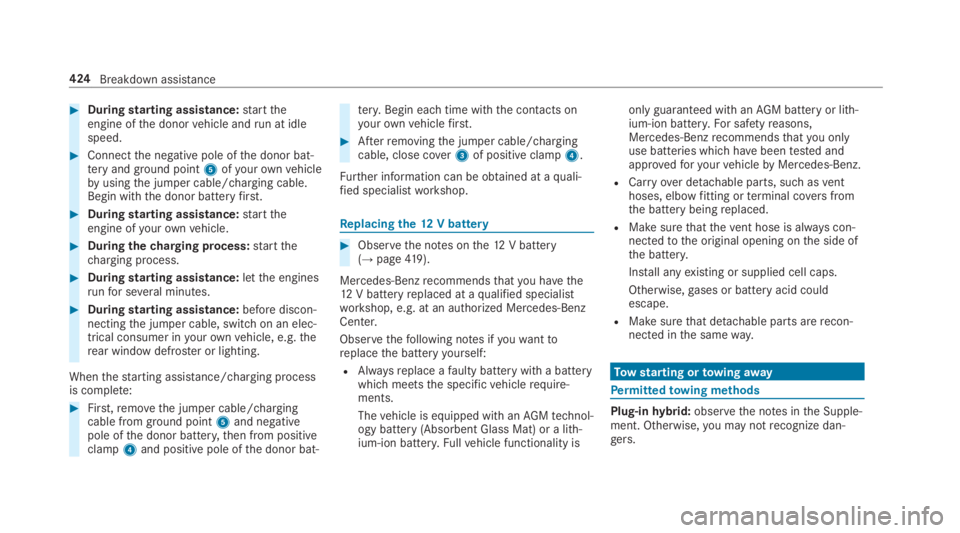
#Duringstarting assistance:starttheengine ofthe donorvehicle andrun at idlespeed.
#Connectthe negative pole ofthe donor bat‐teryandground point5ofyourownvehiclebyusingthe jumper cable/charging cable.Begin withthe donor batteryfirst.
#Duringstarting assistance:starttheengine ofyourownvehicle.
#Duringthecharging process:startthecharging process.
#Duringstarting assistance:letthe enginesrunfor several minutes.
#Duringstarting assistance:before discon‐nectingthe jumper cable, switch on an elec‐trical consumer inyourownvehicle, e.g.therear windowdefroster or lighting.
Whenthestarting assistance/charging processis complete:
#First,removethe jumper cable/chargingcable from ground point5and negativepole ofthe donor battery,then from positiveclamp4and positive pole ofthe donor bat‐
tery. Begin eachtime with the contacts onyourownvehiclefirst.
#Afterremovingthe jumper cable/chargingcable, close cover3of positive clamp4.
Further information can be obtained at aquali‐fied specialistworkshop.
Replacing the12V battery
#Observethe notes onthe12V battery(→page419).
Mercedes-Benzrecommendsthatyou havethe12V batteryreplaced at aqualified specialistworkshop, e.g. at an authorized Mercedes-BenzCenter.
Observethefollowing notes ifyouwanttoreplacethe batteryyourself:
RAlwaysreplace afaulty batterywith a batterywhich meetsthe specificvehiclerequire‐ments.
Thevehicle is equipped with anAGMtechnol‐ogy battery (Absorbent Glass Mat) or a lith‐ium-ion battery.Fullvehicle functionality is
only guaranteed with anAGM battery or lith‐ium-ion battery.For safetyreasons,Mercedes-Benzrecommendsthatyou onlyuse batteries which havebeentested andapprovedforyourvehiclebyMercedes-Benz.
RCarryover detachable parts, such asventhoses, elbowfitting orterminal coversfromthe battery beingreplaced.
RMake surethatthevent hose is alwayscon‐nectedtothe original opening onthe side ofthe battery.
Install anyexisting or supplied cell caps.
Otherwise,gases or battery acid couldescape.
RMake surethat detachable parts arerecon‐nected inthe sameway.
Towstarting ortowingaway
Permittedtowing methods
Plug-inhybrid:observethe notes inthe Supple‐ment. Otherwise,you may notrecognize dan‐gers.
424Breakdown assistance
Page 456 of 578
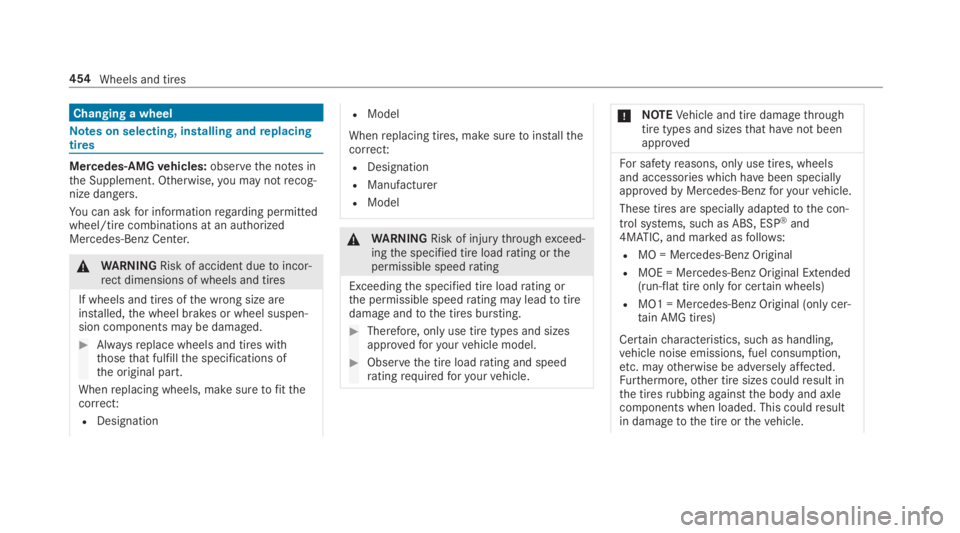
Changing a wheel
Notes on selecting, installing andreplacingtires
Mercedes-AMGvehicles:observethe notes inthe Supplement. Otherwise,you may notrecog‐nize dangers.
You can askfor informationregarding permittedwheel/tire combinations at an authorizedMercedes-Benz Center.
&WARNINGRisk of accident duetoincor‐rect dimensions of wheels and tires
If wheels and tires ofthe wrong size areinstalled,the wheel brakes or wheel suspen‐sion components may be damaged.
#Alwaysreplace wheels and tires withthosethat fulfillthe specifications ofthe original part.
Whenreplacing wheels, make suretofitthecorrect:
RDesignation
RModel
Whenreplacing tires, make suretoinstallthecorrect:
RDesignation
RManufacturer
RModel
&WARNINGRisk of injurythroughexceed‐ingthe specified tire loadrating orthepermissible speedrating
Exceedingthe specified tire loadrating orthe permissible speedrating may leadtotiredamageandtothe tires bursting.
#Therefore, only use tire types and sizesapprovedforyourvehicle model.
#Observethe tire loadrating and speedratingrequiredforyourvehicle.
*NOTEVehicle and tire damagethroughtire types and sizesthat havenot beenapproved
For safetyreasons, onlyuse tires, wheelsand accessories which havebeen speciallyapprovedbyMercedes-Benzforyourvehicle.
These tires are specially adaptedtothe con‐
trol systems, such as ABS, ESP®and4MATIC, and marked asfollows:
RMO = Mercedes-Benz Original
RMOE = Mercedes-Benz Original Extended(run-flat tire onlyfor certain wheels)
RMO1 = Mercedes-Benz Original (only cer‐tain AMG tires)
Certaincharacteristics, such as handling,vehicle noise emissions, fuel consumption,etc. mayotherwise be adversely affected.Furthermore,other tire sizes couldresult inthe tiresrubbing againstthe body and axlecomponents when loaded. This couldresultin damagetothe tire orthevehicle.
454Wheels and tires
Page 474 of 578
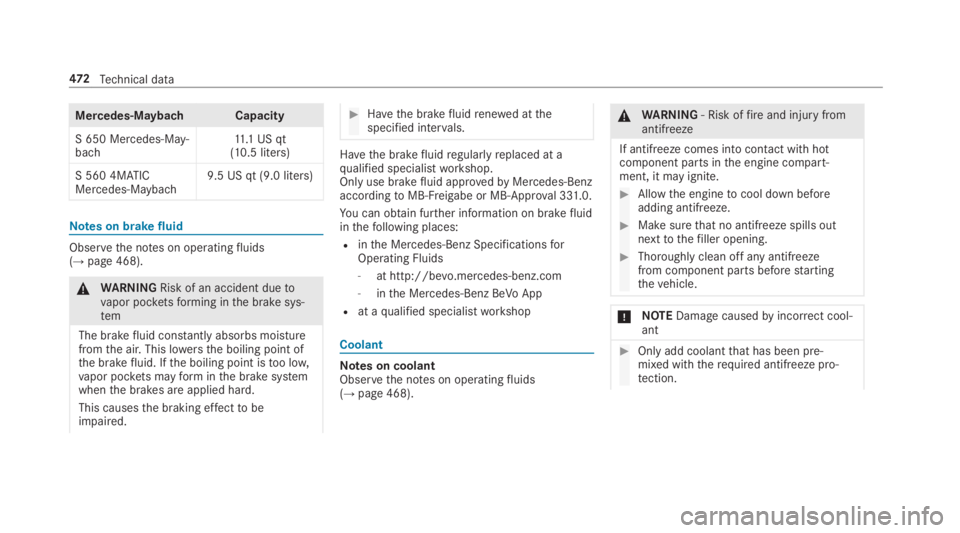
Mercedes‑MaybachCapacity
S 650 Mercedes-May‐bach11.1US qt(10.5 liters)
S 560 4MATICMercedes-Maybach9.5 US qt (9.0 liters)
Notes on brakefluid
Observethe notes on operatingfluids(→page 468).
&WARNINGRisk of an accident duetovapor pocketsforming inthe brake sys‐tem
The brakefluid constantly absorbs moisturefromthe air. This lowersthe boiling point ofthe brakefluid. Ifthe boiling point istoo low,vapor pockets mayforminthe brake systemwhenthe brakes are applied hard.
This causesthe braking effecttobeimpaired.
#Havethe brakefluidrenewed atthespecified intervals.
Havethe brakefluidregularlyreplaced at aqualified specialistworkshop.Only use brakefluid approvedbyMercedes-BenzaccordingtoMB-Freigabe or MB-Approval 331.0.
You can obtain further information on brakefluidinthefollowing places:
Rinthe Mercedes-Benz SpecificationsforOperating Fluids
-at http://bevo.mercedes-benz.com
-inthe Mercedes-Benz BeVo App
Rat aqualified specialistworkshop
Coolant
Notes on coolantObservethe notes on operatingfluids(→page 468).
&WARNING‑ Risk offireand injury fromantifreeze
If antifreeze comes into contact withhotcomponent parts inthe engine compart‐ment, it may ignite.
#Allowthe enginetocool down beforeadding antifreeze.
#Makesurethat no antifreeze spills outnexttothefiller opening.
#Thoroughly clean off any antifreezefrom component parts beforestartingthevehicle.
*NOTEDamagecausedbyincorrect cool‐ant
#Only add coolantthat has been pre‐mixed withtherequired antifreeze pro‐tection.
472Technical data
Page 488 of 578
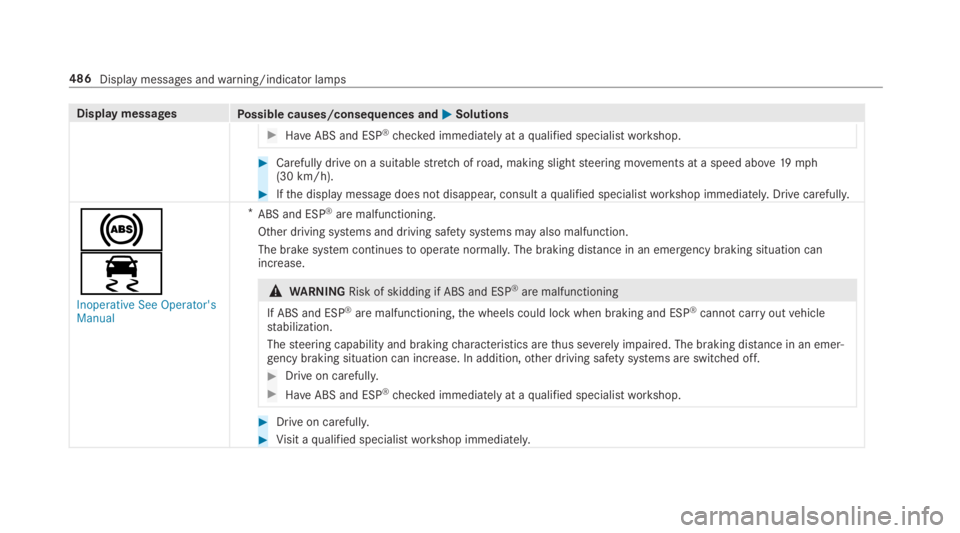
Display messagesPossible causes/consequences and�P�PSolutions
#HaveABS and ESP®checked immediately at aqualified specialistworkshop.
#Carefully drive on a suitablestretch ofroad, making slightsteering movements at a speed above19mph(30 km/h).
#Ifthe display message does not disappear, consult aqualified specialistworkshop immediately. Drive carefully.
�%
�